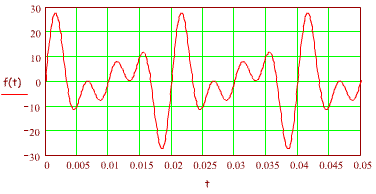| Periodic Signals |
A Note About Periodic Signals - What is the frequency of a periodic signal.
(If the frequency is 50 Hz,
why is there no component at 50 Hz?)
There are many cases
where you examine periodic signals, and you make certain assumptions. Some
years ago, a student did a project with some chimes and examined the frequency
content of the tones that they produced. There were some surprises in the
signals he recorded, and the phenomenon that he found there is what this note is
about. There are always a few surprises in this business, so here we go.
Here is an expression for
a signal.
- f(t) = 10 sin(2p*100t)
+ 10 sin(2p*150t)
+ 10 sin(2p*200t)
This signal is periodic. The
question is "What is the frequency of this signal?"
The Answer To The Question
At first you might want to
say that the frequency of the signal is 100 Hz since that is the lowest
frequency sine wave in the signal. However, 150 Hz is not a harmonic of 100 Hz,
and you have to be careful. It helps if you graph the signal. Here is a graph
from Mathcad.

- Notice that the
repetition period is .02 seconds, implying a 50 Hz repetition rate.
- Also notice that 100, 150
and 200 Hz are all harmonics of 50 Hz.
- The conclusion is that
you can have a signal that is periodic with a fundamental frequency, but
that there does not need to be a signal at the fundamental frequency.
What we can conclude is that we don't
have to have any component at the fundamental of a signal. If we have a signal
that repeats every T seconds, there is no guarantee that the signal will have a
component at a frequency of 1/T.
|